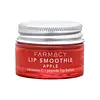What's inside
What's inside
 Key Ingredients
Key Ingredients

 Benefits
Benefits

 Concerns
Concerns

 Ingredients Side-by-side
Ingredients Side-by-side

Hydrogenated Polyisobutene
EmollientDiisostearyl Malate
EmollientPhytosteryl/Isostearyl/Cetyl/Stearyl/Behenyl Dimer Dilinoleate
Skin ConditioningCaprylic/Capric Triglyceride
MaskingPolybutene
Mangifera Indica Seed Butter
Skin ConditioningSynthetic Wax
AbrasiveEthylene/Propylene/Styrene Copolymer
Euphorbia Cerifera Wax
Brassica Campestris/Aleurites Fordi Oil Copolymer
Skin ConditioningButyrospermum Parkii Butter
Skin ConditioningTetrahexyldecyl Ascorbate
AntioxidantPalmitoyl Tripeptide-1
Skin ConditioningPyrus Malus Fruit Extract
Skin ConditioningGlycerin
HumectantMoringa Oleifera Seed Oil
EmollientCurcuma Longa Leaf Extract
Skin ConditioningSolanum Melongena Fruit Extract
Skin ConditioningCoccinia Indica Fruit Extract
Skin ConditioningOcimum Sanctum Leaf Extract
Skin ConditioningCorallina Officinalis Extract
Skin ConditioningMelia Azadirachta Leaf Extract
Skin ConditioningMelia Azadirachta Flower Extract
Skin ConditioningMelia Azadirachta Extract
Skin ConditioningTocopherol
AntioxidantTribehenin
EmollientEthylhexyl Palmitate
EmollientGlyceryl Caprylate
EmollientMalic Acid
BufferingLactic Acid
BufferingSorbitan Isostearate
EmulsifyingAmber Powder
Pentaerythrityl Tetra-Di-T-Butyl Hydroxyhydrocinnamate
AntioxidantButylene/Ethylene/Styrene Copolymer
Aroma
Limonene
PerfumingHydrogenated Polyisobutene, Diisostearyl Malate, Phytosteryl/Isostearyl/Cetyl/Stearyl/Behenyl Dimer Dilinoleate, Caprylic/Capric Triglyceride, Polybutene, Mangifera Indica Seed Butter, Synthetic Wax, Ethylene/Propylene/Styrene Copolymer, Euphorbia Cerifera Wax, Brassica Campestris/Aleurites Fordi Oil Copolymer, Butyrospermum Parkii Butter, Tetrahexyldecyl Ascorbate, Palmitoyl Tripeptide-1, Pyrus Malus Fruit Extract, Glycerin, Moringa Oleifera Seed Oil, Curcuma Longa Leaf Extract, Solanum Melongena Fruit Extract, Coccinia Indica Fruit Extract, Ocimum Sanctum Leaf Extract, Corallina Officinalis Extract, Melia Azadirachta Leaf Extract, Melia Azadirachta Flower Extract, Melia Azadirachta Extract, Tocopherol, Tribehenin, Ethylhexyl Palmitate, Glyceryl Caprylate, Malic Acid, Lactic Acid, Sorbitan Isostearate, Amber Powder, Pentaerythrityl Tetra-Di-T-Butyl Hydroxyhydrocinnamate, Butylene/Ethylene/Styrene Copolymer, Aroma, Limonene
Dimethicone 1%
EmollientEthylhexyl Methoxycinnamate 7.5%
UV AbsorberBenzophenone-3 2.5%
UV AbsorberAlumina
AbrasiveBeeswax
Emulsion StabilisingBlue 1 Lake
Cosmetic ColorantDiethylhexyl Adipate
EmollientEthylhexyl Palmitate
EmollientEthylhexyl Stearate
EmollientAroma
Glyceryl Stearate
EmollientHydrogenated Coconut Oil
EmollientIsopropyl Myristate
EmollientIsopropyl Palmitate
EmollientIsopropyl Stearate
EmollientJojoba Esters
EmollientMicrocrystalline Wax
Emulsion StabilisingMyristyl Myristate
EmollientPhenoxyethanol
PreservativePhenyl Trimethicone
Skin ConditioningPolyethylene
AbrasivePolyhydroxystearic Acid
EmulsifyingCI 15850
Cosmetic ColorantSaccharin
MaskingSilica
AbrasiveTetrahexyldecyl Ascorbate
AntioxidantTitanium Dioxide
Cosmetic ColorantTocopheryl Acetate
AntioxidantSolvent Yellow 33
Dimethicone 1%, Ethylhexyl Methoxycinnamate 7.5%, Benzophenone-3 2.5%, Alumina, Beeswax, Blue 1 Lake, Diethylhexyl Adipate, Ethylhexyl Palmitate, Ethylhexyl Stearate, Aroma, Glyceryl Stearate, Hydrogenated Coconut Oil, Isopropyl Myristate, Isopropyl Palmitate, Isopropyl Stearate, Jojoba Esters, Microcrystalline Wax, Myristyl Myristate, Phenoxyethanol, Phenyl Trimethicone, Polyethylene, Polyhydroxystearic Acid, CI 15850, Saccharin, Silica, Tetrahexyldecyl Ascorbate, Titanium Dioxide, Tocopheryl Acetate, Solvent Yellow 33
 Reviews
Reviews

Alternatives
Ingredients Explained
These ingredients are found in both products.
Ingredients higher up in an ingredient list are typically present in a larger amount.
Aroma refers to an ingredient, or mixture of ingredients, that impart or mask a flavor.
The name is slightly confusing. This is because INCI associates aroma with flavor instead of smell.
Here is the official definition from the The International Cosmetic Ingredient Dictionary and Handbook:
“Aroma is a term for ingredient labeling used to identify that a product contains a material or combination of materials normally added to a cosmetic to produce or to mask a particular flavor.”
INCI shows the only purpose of aroma to be "flavouring".
However, due to regulation differences, some companies may use aroma in place of parfum.
In Canada, this ingredient only has to be listed in concentrations above 1%.
Learn more about AromaEthylhexyl Palmitate, also known as octyl palmitate, is created from 2-ethylhexyl alcohol and palmitic acid. It is a fatty acid ester.
The fatty acid content of Ethylhexyl Palmitate makes it an emollient. Emollients help soften and hydrate your skin by trapping moisture within.
Ethylhexyl Palmitate is also used to help improve the texture of cosmetics. It helps other ingredient dissolve in products and help disperse ingredients more evenly.
You'll likely find this ingredient in sunscreen, as it is often used to mix UV-blocking ingredients such as avobenzone and ethylhexyl triazone.
It can also help stabilize the fragrances in a product as a fragrance fixative.
Ethylhexyl Palmitate can be used to substitute mineral oil.
Due to its high fatty acid content, it may not be fungal-acne safe.
Learn more about Ethylhexyl PalmitateTetrahexyldecyl Ascorbate (THD) is a stable and oil-soluble form of Vitamin C.
THD is special in that it has the ability to travel deeper into skin than traditional ascorbic acid while maintaining the same skin benefits (double win!).
Because it’s oil-soluble, THD dives deep into your skin’s fatty layers (think ceramides and cholesterol) to fight off the kind of free radicals that mess with your skin barrier. This makes it a great pair with water-based vitamin C (ascorbic acid) that mainly works on the surface.
Even at just 0.1%, THD is already showing great antioxidant activity. When used up to 2%, it helps keep your skin happy and calm, especially when it’s stressed from pollution or sun.
Want to fade dark spots or tackle hyperpigmentation? You’ll want 5% or more. Pairing it with brightening buddies like niacinamide or licorice root gives even better results. One study even used 30% THD with other brighteners and saw real results on stubborn discoloration, even in melasma-prone skin.
A note on THD: It’s has a slightly silky, oily texture and usually shows up colorless or pale yellow (though the exact shade can vary by supplier).
While you can sneak it into water-based formulas, it really shines when paired with silicones or oils, which help your skin soak it up better.
THD is pretty stable, but it’s still vulnerable to degradation like ascorbic acid. Too much light or heat (above 113°F / 45°C) can break it down over time. Go for dark and opaque packaging that keeps it safe and shady!
Read more about other types of Vitamin C:
Learn more about Tetrahexyldecyl Ascorbate